Posted by Amaranth
A Morbid Fascination

Goth has always had the touch of macabre about it. The themes bubbling up through the music, fashion and art are definitely pulled from the darker side of life. Indeed even the term “gothic” was used to describe what many thought of as barbaric and grotesque architecture and then latter was adopted by literature which combined the horrible with the romantic, a paradox that ultimately echos the extremes of human nature and brings it home that we are both the villain and the valiant.
It’s no surprise then when the dark underground music that grew from post-punk took the label too and with it took many of the morbid fascinations. However, being entrenched in the gothic scene as I am, and quite the one for all the clichés it brings with it – I think many see this delight in the dark as a negative thing. Whereas, I see it as embracing the more sombre side and owning it. Knowing that there’s no point in taking life too seriously – none of us are going to get out alive anyway. It’s with a wry, black-lipped smile that many goths curl up in their claw footed couch and place their black coffee on a coffin shaped table while watching reruns of Dracula (back when Vampires didn’t sparkle!). Alicia from Gothicsubculture.com sums it up nicely, “Many Goths say that Gothic represents acceptance of the inevitability of death and the existence of the darker side of life. That does not mean that Goths possess an obsession with either one. Goth is recognizing the balance of dark and light, life and death, without turning away, denying, or living in fear of the things some people find disturbing. For some Goths, it is an acceptance of the inevitable that makes them appreciate life and live it to the fullest from day to day.”
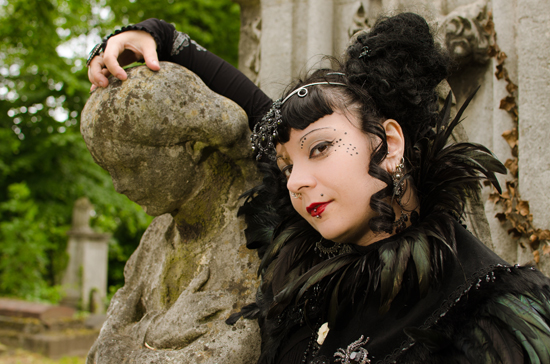
It’s with this same fervour that goths flock to graveyards and the open days held by some of the magnificent seven dotted around London. Kensal Green hosts an annual open day which is particularly popular with the black-clad masses. Signe Hoffos from the Friends of Kensal Green organisation who look after the cemetery has noted the attraction and said, “We look forward to seeing the Goths on Open Day, as almost everyone is so very polite, well-dressed and well-behaved,” although also added, “That said, this might also be a good opportunity to ask the errant one or two to dress respectfully: we love the leather, lace and velvet, but it is a working cemetery, and not a theme park, so joke-shop masks are wholly inappropriate, and offensive particularly to visitors who are tending the graves of their recently departed.” And I think that is definitely a sentiment that should be taken to heart and indeed applied to all we do. We needn’t feel we have to stress our right to adorn ourselves exactly as we see fit when we see fit, with no thought to other people or our surrounds – a modicum of respect and consideration goes a long way and there’s still plenty of great styling options one can explore.
This year it was on Saturday 5th July and focussed on the Dissenters’ Chapel and its small catacomb as unfortunately the large catacomb beneath the Anglican Chapel is closed for the foreseeable future, as the air is so laden with allergens that the General Cemetery Company has been advised that it isn’t safe to visit until the whole complex is restored and all the damp and mould arrested. However there will still be the usual display and motorcade of classic hearses as well as stalls and cemetery tours. Definitely worth a visit – so don your finest Victorian mourning garb, grab a picnic basket and head to Kensal Green enjoy a day among the dead.
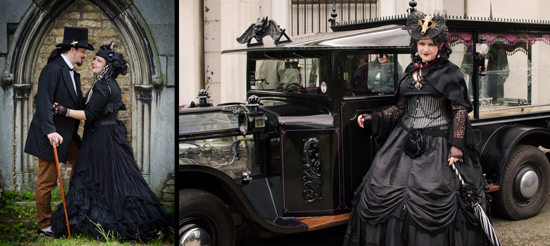 I wanted to explore this fascination goths have with death and delve further into the subject itself and thought who better to ask than a lady who is not only a goth, but a scholar in the subject and someone who gets up-close-and-personal with death on a daily basis. Marta Poppycat (Wozniak) is one of around only 30 top qualified Funeral Directors in the UK, and the only non-Brit (she originates from Poland) and is currently in her final year of an MA in Death, Religion and Culture at the University of Winchester, having previously studied social Psychology & Funeral Services. With an academic background being a mixture of Social Psychology with a focus on bereavement and practical issues such as law & legislation of burial grounds, body tissue identification & handling, and mass fatalities. She is currently works in a funeral home during the day, and by night she dons corsets and lace and stalks the gothic London club scene.
I wanted to explore this fascination goths have with death and delve further into the subject itself and thought who better to ask than a lady who is not only a goth, but a scholar in the subject and someone who gets up-close-and-personal with death on a daily basis. Marta Poppycat (Wozniak) is one of around only 30 top qualified Funeral Directors in the UK, and the only non-Brit (she originates from Poland) and is currently in her final year of an MA in Death, Religion and Culture at the University of Winchester, having previously studied social Psychology & Funeral Services. With an academic background being a mixture of Social Psychology with a focus on bereavement and practical issues such as law & legislation of burial grounds, body tissue identification & handling, and mass fatalities. She is currently works in a funeral home during the day, and by night she dons corsets and lace and stalks the gothic London club scene.
What was it that made you want to go into the study of death?
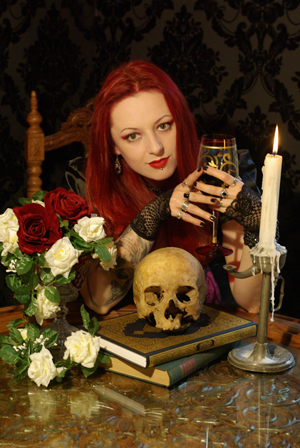 I began studying psychology six years ago with bereavement studies in mind. I was thrilled to discover that death studies are available in the UK so I decided to complete my masters degree in this. Apart from being incredibly fascinating, I find it beneficial for my current work: many problems that my clients experience come from a preoccupation with social and cultural expectations. My degree gives me a solid background and the credibility to help families who often feel guilty and lost in a situation that is overwhelming for them. I enjoy helping them to ‘tune in’ to what they feel is truly important for them and for the deceased. All rituals, including funerals, are man-made, but people seem to forget this thinking that there must be some kind of law or ‘correct’ way of dealing with death – there isn’t. Essentially, death is personal and only really involves the dead and those who feel the loss of that person.
I began studying psychology six years ago with bereavement studies in mind. I was thrilled to discover that death studies are available in the UK so I decided to complete my masters degree in this. Apart from being incredibly fascinating, I find it beneficial for my current work: many problems that my clients experience come from a preoccupation with social and cultural expectations. My degree gives me a solid background and the credibility to help families who often feel guilty and lost in a situation that is overwhelming for them. I enjoy helping them to ‘tune in’ to what they feel is truly important for them and for the deceased. All rituals, including funerals, are man-made, but people seem to forget this thinking that there must be some kind of law or ‘correct’ way of dealing with death – there isn’t. Essentially, death is personal and only really involves the dead and those who feel the loss of that person.
Did this interest precede, follow or coincide with you interest in Goth?
I have always had an interest in death. I remember the peace and tranquillity of the nineteenth century cemetery opposite my primary school where I often spent a lot of my time. I wrote my first vampire story when I was 10 years old, and this was followed a couple years later with poems and songs about death. I never felt that there was anything wrong with me, but I often heard this from others who tried to ‘fix me’ by attempting to make me more cheerful while failing to see that I was in fact quite happy and content. One group that has embraced me and accepted me for what I am was Goth subculture with its sensitivity and appreciation of the darker side of life. Another one was academia, where I am free to ponder on the apparently morbid side of human existence.
In terms of my appearance, I ‘changed my feathers’ a decade ago. Although it is inevitable, I have never been keen on the idea of defining myself through group identity rather than my own. I also didn’t like the restriction of ‘dress code’ and it was only after I moved to London that I have learned to appreciate the benefits of this is who I am: deal with it or don’t bother me statement can make. The clothes also feel more like a shield that keeps some people away, so I could enjoy the company of friends and date men who cultivate the manners of Victorian gentlemen. Perfect!
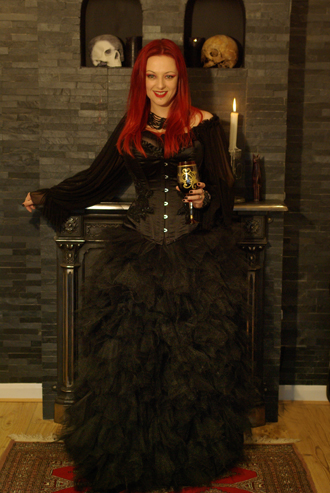 How do you feel these two interests marry up and why is it many Goths have an attraction to this sort of thing?
How do you feel these two interests marry up and why is it many Goths have an attraction to this sort of thing?
I am reluctant to answer this on behalf of other people. To this day I fail to understand how glow sticks or the ‘bleepy’ sound of some bands relate to the Goth scene, just as many people wearing skull t-shirts never gave a real thought on what a skull actually is. I like to believe that generally Goths are a subculture with a particular sensitivity and uncompromised ethics that result in an affinity towards the darker side of life. For example, many Goths are involved in animal welfare because they chose not to ignore the ugly side of human actions. I also think that because death has the ultimate power upon all that lives, there is a certain attraction in engaging with something so final.
Many Goths adopt a romanticised love of death and its trappings – however you see the real side of it through your work – how disparate do you think these two ideas are?
I think Goths are romantic, elegant creatures to whom love is eternal and lasts beyond death. This is represented in gothic literature, the vampire type of love, the music, the fog, and the darkness. The Victorian era with its revival of gothic style as the ‘correct ‘one for use in churches and gravestones has been described as an era of a beautiful death. People would die at home surrounded by loved ones, with the Christian promise of being reunited in the afterlife. Death was visual and brought with it a booming industry that produced mourning clothes, mourning jewellery and other artefacts. Even burial grounds were designed as garden cemeteries that were meant to encourage families to come over for a Sunday stroll. You could purchase guide books at the entrance gate that would tell you who was buried where and the location of expensive and exotic plants & trees.
If you visit a cemetery today, many of the beautiful sculptures are vandalised and the ground is overgrown. The perception of death has changed drastically, especially after the Great War and the increase of secularisation. Many cemeteries have been abandoned and the majority of people in the UK are now being cremated. At cremations, ashes are often scattered and mourners advised to ‘move on’. The ‘myth of closure’ that was so popular and encouraged in twentieth century therapy failed to recognise that including the deceased in everyday life-continuing bonds, as it is known-can actually help to cope. I despair thinking that our society seems to have forgot that a hundred percent of us will die: this is not optional and pretending that it is not going to happen only makes coping with death worse. It is a flaw of the past millennium, when death became medicalised, moved away from our view and denied.
I myself am inclined towards the Victorian romanticised view of death with the eternal commitment to those we love, whether it’s a child, a partner or a parent. We will lose every single person that we love, or they will lose us, and the best we can do is to find ways of continue these relationships by remembering them and by not ruining our lives by dwelling in pain. To me, having a grave to visit, or keeping some items that belonged to the deceased is not such a bad idea, because that way we can connect with something they touched, something that smells of them. It is up to us how we chose to deal with death of a loved person. It all comes down to people’s ability to cope and understand death, which proves that it is crucial to remember that just like birth, death is natural, real, and can happen to anyone, anytime.
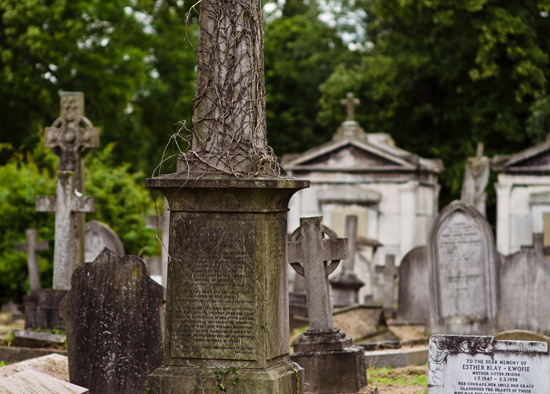
Could you tell me a bit more about your job?
I work in a funeral home mainly dealing with families and I make funeral arrangements on their behalf. These involve the booking of a church, crematorium or burial space. I usually spend about a week with them. Sometimes I accompany them in the chapel of rest, sometimes I do make up. I also deal with the deceased in the mortuary as UK legislation requires that all deceased that are to be cremated need to be examined by two doctors. During my training I assisted with all aspects of work in a funeral home from embalming procedures to coffin making. I have witnessed post mortem examinations and I have collected a number of deceased from regular deaths to murders and suicides. I have also dealt with death of babies and children of all ages, including abortions (as they are cremated too). I deal with repatriations and I organise funerals for all faiths.
I wear a uniform for work; it is a black suit and a white or purple shirt. I always wear long sleeves to cover my tattoos and I don’t wear makeup. The only real give-away is my red hair. People rarely comment on this as they are usually preoccupied with their own problems, fortunately the business owner is a liberal person who does not interfere with my personal style. I am very lucky to not to be told to dye my hair a ’normal’ colour. I would be careful though with certain professions-particularly medical and death related-to display personal style at work, especially one so stigmatized and confused with Satanism and corpse obsession as goth subculture. This is business and nobody wants to lose customers.
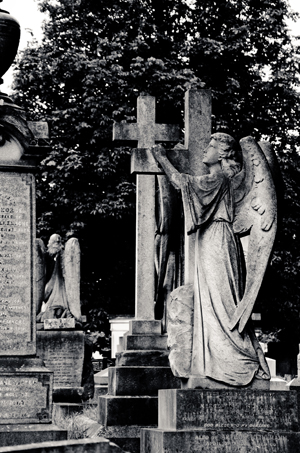 How do you think people’s view and attitude to death has changed over the years? Are there any periods and/or cultures who you particularity admire in relation to their death customs?
How do you think people’s view and attitude to death has changed over the years? Are there any periods and/or cultures who you particularity admire in relation to their death customs?
I appreciate every culture that accepts death as a normal part of life, and there are many of them apart from, sadly, our own. Western culture has created a society where nobody talks about death as it is currently perceived as too morbid and too negative. Around 1500 people die in UK every day, yet most people manage to go through life without seeing a single corpse. People die alone in hospitals, the body is taken by the funeral directors and that’s it. We have created a society where the only experiences of another person’s death are through TV programmes or computer games, making this even more surreal. Moreover, in the West, the cremation must fit in between busy life styles and even road traffic although this is the last time the relatives will have to make time for the deceased! No life should be disposed of and forgotten, and nobody should die alone. In that respect the West has a lot to re-learn. The times when the body remained at home are long gone; they are now replaced by lawsuits accusing hospitals for failing to keep hundred year old grannies alive. Cemeteries have became an offensive landscape and visiting them suggests clinging to the past or a morbid way of relaxing!
There are so many death rites that evolve around love and respect towards the deceased. The Muslim communities always find time to wash and dress their deceased, the Catholic community gather at the church and they always visit their loved ones at cemeteries bringing flowers and chatting away either to the corpse in the ground or to others visiting graves. Think of the Mexican Day of the Dead celebrations! In Greece, up until only fifty years ago people would dig the bones of the deceased five years after the burial, clean them and place them in the ossuary. The whole community would gather for the secondary burial. The indigenous people of Wari’ who lived in Brazilian Amazonian forest would ritually eat their deceased. It was considered an honour, and a way of caring. At the core of all this is the fact that the corpse is never just a corpse: it remains as a community member and is treated accordingly. The connection is not ‘chopped off’ and I really believe that this is where we go wrong: by forcing ourselves to forget and move on, and by demonising nature.
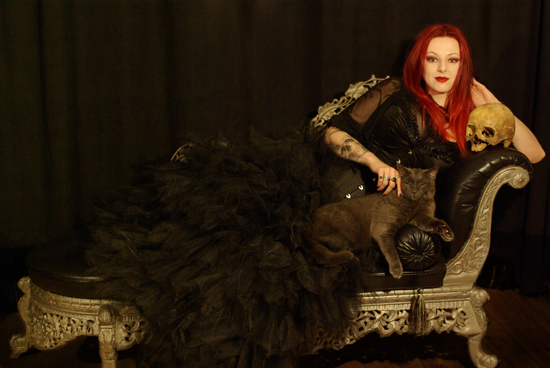
Describe what you want your funeral to be like and what would your epitaph be?
The purpose of the funeral rites is to honour the memory of the deceased and to say good bye to them. I’d be grateful if someone would just put me in the coffin with no interference and certainly no embalming. Simple cremation with no ritual and with my friends around would be great. What is more important to me is for some of my ashes to be scattered in a place that I actually specified in my will, with the rest interred in a family grave with my parents, cats and my husband. The epitaph is probably best chosen by others, but I like the idea of a sculpture of an angel holding a cat (instead of a lamb) above the grave! I like the message it sends to the religious communities, that all life is equally loved and protected by God. So, if I were to justify such expense, I would love my-obviously gothic style memorial-to be a clear statement that this family treated animals as equal family members-which is the case for us.
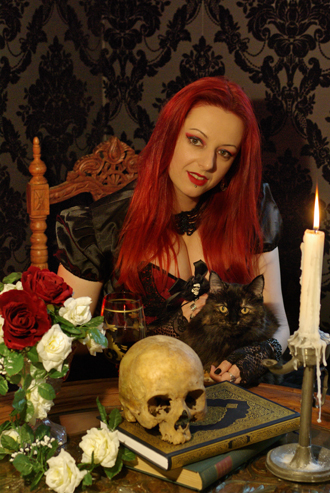 What would you advise anyone else thinking of going into the funeral profession?
What would you advise anyone else thinking of going into the funeral profession?
I think people are often confused with what working in a funeral home means. It is probably more important to know why you want to do this rather than what you want to do. The ‘front of house’ is essentially an admin job, while ‘the back house’ involves the practical preparations such as dressing the body and the coffin, preparing viewings for mourners prior to the actual funeral. The funeral director, the Man in the Hat conducts the funeral on the day, which involves stressing over traffic, time and people management. It is not a particularly well paid job and not highly thought of and it does not offer a good career opportunity. The novelty wears off and the reality hardly resembles the TV series “Six Feet Under”, as people hardly spend thousands on facial reconstruction. In UK this is still unregulated and anyone can do it, while in USA everyone must study and gain a licence. American TV fiction clashes with the reality of opportunists who operate from rented offices with rented cars, because British law allows it. Basically, if you can’t remember that this job involves looking after someone’s parent or a child with the entire package that includes tears, anger and also soiled clothes and decomposition of body tissue – then don’t even think of doing it. There is nothing more crucial than empathy and caring nature that is needed for this job – something that generates strength and a frame of mind that allows us to cope with the job that is very stressful and intense. Those who objectify the clients, whether dead or alive, would find more satisfaction working on a building site or running banks, as this is not a good way of dealing with someone’s vulnerability.
To me, the ‘thrill’ and true reward comes from knowing that during the time I have spent with the relatives I can help them through this difficult part of their life by doing ‘what’s right’ for their loved one. Funeral directors are often the first, and sometimes the only people with whom the bereaved are able to talk about death and the deceased, because this is the sole purpose of the funeral arrangement. I spend many hours with families chatting by the coffin that they had to choose, helping them do nails for mums, looking at family photographs and learning about the deceased from them. I like to believe that these very personal moments help others with facing what has taken place and also give them a little strength to rebuild their lives. Essentially, I believe that the good things we do for others will generate good energy, somewhere, for someone. We live in a world where putting rubbish in the bin is a huge cultural achievement and where people forget what caring for others means. I know that a little kindness can go a long way, and the best compliments I ever heard in my life come from the families I have helped. I promise you, there is no greater reward than knowing that someone coped with the pain and the loss better because of the way I helped them in their time of bereavement.
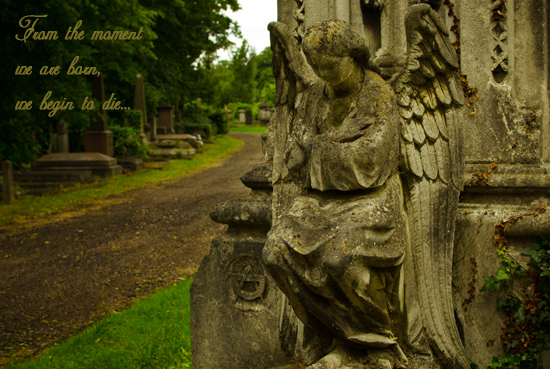
Photo Credits
Photos of Marta by Arcadia Noir
Kensal Green photos by Stevek Photography
Published in Devolution
